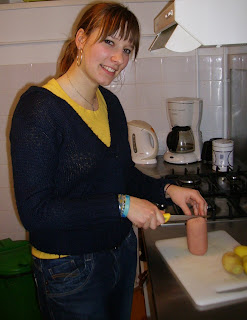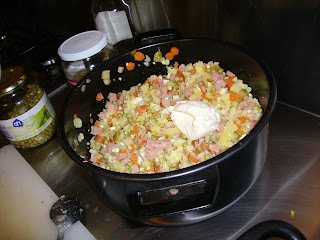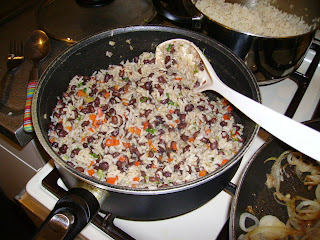 Nanda has invited over Digne, a friend who lives in the Hague as well. They met up through a Latvian "Myspace" type website. Digne was checking out the profiles and..."Hey! There are more Latvians here in the Hague!" So now she is here, the official inspector of Rosols, the special potato salad served on birthdays, holidays and all other special occasions. It's a festive dish, but "even boys know how to make it!" Nanda's father often makes it for her when she
Nanda has invited over Digne, a friend who lives in the Hague as well. They met up through a Latvian "Myspace" type website. Digne was checking out the profiles and..."Hey! There are more Latvians here in the Hague!" So now she is here, the official inspector of Rosols, the special potato salad served on birthdays, holidays and all other special occasions. It's a festive dish, but "even boys know how to make it!" Nanda's father often makes it for her when she 's back in Riga for a visit. The last couple of years she's lived in France (to study sound engineering) and here in Holland (to study ArtScience).
's back in Riga for a visit. The last couple of years she's lived in France (to study sound engineering) and here in Holland (to study ArtScience).While we're chopping and dicing the sausage, carrots, gherkins, eggs and potatoes, Nanda tells me lots about Latvia. Russia plays a big part in its recent history, they occupied Latvia till 1990. Till then, all "official" things, like shop fronts or tram tickets, were in Russian. After independence, everything was written in Latvian, but on some facades, the bleached out shadows of the Russian letters are still visible. There's quite a polemic going on now about the language, as the big Russian minority (almost a third of the population) want Russian to become the offical second language of the nation. Nanda was even affected by this struggle 
Nanda tells me sometimes at the market she will be speaking to the vendors in Latvian and they will answer in Russian. A bilingual dialogue... The salad progresses and Digne inspects the proportions of the different ingredients. The pieces have to be chopped very finely, as “only grandma’s make rosols with big chunks!” Then generous amounts of sour cream and mayonnaise are added. The aspect mostly reminds me of potato salads I have had in the past at barbecues or parties. But here in Holland it doesn’t have a special name or significance…and often it’s bought at the supermarket and not made at home. Which does make a big diffe
After dinner we enjoy a cup of lindenflower tea, with lindenflower honey to sweeten it, also typical for grandmothers according to Nanda and Digne. To accompany it, some rock hard caramels that need an unexpected amount of violence to separate them from their friends. Here at right you see Nanda holding a Latvian souvenir…it’s a bread that’s a couple of months old, but she doesn’t want to throw it away just yet. Amazingly, this “real” bread just turns hard and doesn’t get moldy.
Click here for the original Rosols recipe. It's easy to make!





